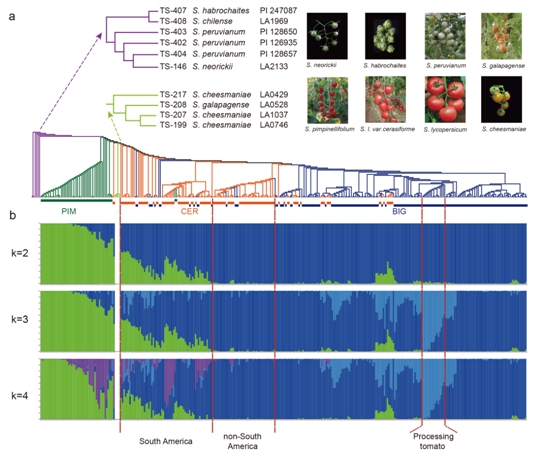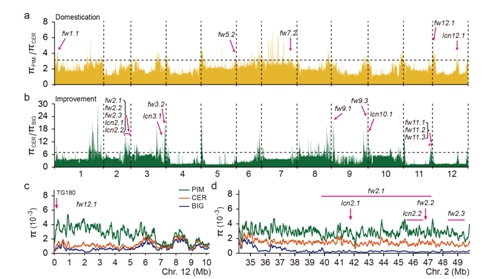分享到
Genomic Analyses Provide Insights into the History of Tomato Breeding
Most of the food we consuming today are derived from the results of plant breeding, which human have transformed the wild type plants into cultivated crops. Tomato (Solanum lycopersicum) is an economically important vegetable crop with worldwide distribution and also an important model system for plant biology and fleshy fruit development research. However, how human selection has changed the tomato genome per se remains largely unknown. By analyzing the genomes of 360 diverse tomato accessions, an international team led by Prof. Sanwen Huang, a senior scientist from Institute of Vegetables and Flowers, Chinese Academy of Agricultural Sciences (IVF-CAAS), provides insights into the genomic history of tomato breeding.
The excellent work was online published in Nature Genetics on 14 October 2014.
In this study, they constructed a single-nucleotide resolution map of tomato genome variation consisting of 11,620,517 high quality SNPs and 1,303,213 insertions or deletions. “Genetic variation map provides the genetic basis for extensive studies on domestication, improvement, divergence and introgression during tomato breeding,” says Prof. Sanwen Huang.

Figure 1 Genome-wide relationship and fruit morphology in cultivated tomatoes and its wild relatives.
To study the history of tomato breeding including domestication and improvement, they analyzed 330 red fruited accessions including Solanum pimpinellifolium (PIM), S. l. var. cerasiforme (CER), and S. lycopersicum (BIG), which represent wild, improved and currently cultivated tomatoes, respectively. At the whole genome level, the nucleotide diversity of PIM (3.23×10-3) is substantially higher than that of CER (1.74×10-3) and BIG (0.73×10-3). By scanning genomic regions with a drastic reduction of nucleotide diversity between PIM and CER (πPIM/πCER, domestication sweeps) as well as between CER and BIG (πCER/πBIG, improvement sweeps), they identified 186 domestication (occupying 64.6 Mb, 8.3%) and 133 improvement sweeps (occupying 54.5 Mb, 7.0%) of the assembled genome. This team revealed the evolutionary path of how modern tomato fruit have become ~100 times larger than their ancestor. Five QTLs related to fruit mass are contributed to the enlargement of tomato fruits during the evolutionary transition from PIM to CER and 13 QTLs are contributed the second round of fruit enlargement during the transition from CER to BIG.


Figure 2 Evolution of fruit mass during domestication and improvement.
In general, big-fruited tomatoes are bred for fresh consumption or processing. The genome-wide genetic basis underlying the divergence between fresh and processing tomatoes was exploited in the first time. The researchers discovered a major genomic signature of modern processing tomatoes which panned a large portion of the chromosome 5 containing several QTLs controlling soluble solid content and firmness of fruit which is essential trait for modern processing tomato. Using genome-wide association study (GWAS), the researchers identified the causative variants that confer pink fruit color that could be used to breed pink tomato.
Not only zooming into the difference among the three groups, the researchers also precisely visualized linkage drags associated with wild introgressions (disease resistant genes, R genes). “Now that we have understood the precise sizes and positions of these large wild introgressions, efforts can be made to develop molecular markers to overcome linkage drag to maximize the potential of additional wild germplasm.” Huang emphasizes.
An important message conveyed in this study is that human-induced processes, despite their contributions to tomato domestication, resulted in the near fixation of a large proportion of the tomato genome. The sweeps and linkage drags associated with introgression jointly occupy nearly 25.6% of the tomato genome, which becomes a hindrance to further improvement. Huang explains, “The genome sequence and the variation map generated here will facilitate the separation of favorable trait genes from their embedded sweeps and linkage drags by rare recombination or possibly by genome editing.”
“The accomplishments and the costs of historical selection are co-exist, new chassis of tomato genome is needed to design to overcome these adverse effects.” The team is confident to the future breeding assisted by genome and explained “To overcome this limit, breeders need variome-guided selection or genome editing which can be facilitated by the genome information presented herein.”
For more information please visit the complete study at:
http://www.nature.com/ng/journal/vaop/ncurrent/full/ng.3117.html
The excellent work was online published in Nature Genetics on 14 October 2014.
In this study, they constructed a single-nucleotide resolution map of tomato genome variation consisting of 11,620,517 high quality SNPs and 1,303,213 insertions or deletions. “Genetic variation map provides the genetic basis for extensive studies on domestication, improvement, divergence and introgression during tomato breeding,” says Prof. Sanwen Huang.

Figure 1 Genome-wide relationship and fruit morphology in cultivated tomatoes and its wild relatives.
To study the history of tomato breeding including domestication and improvement, they analyzed 330 red fruited accessions including Solanum pimpinellifolium (PIM), S. l. var. cerasiforme (CER), and S. lycopersicum (BIG), which represent wild, improved and currently cultivated tomatoes, respectively. At the whole genome level, the nucleotide diversity of PIM (3.23×10-3) is substantially higher than that of CER (1.74×10-3) and BIG (0.73×10-3). By scanning genomic regions with a drastic reduction of nucleotide diversity between PIM and CER (πPIM/πCER, domestication sweeps) as well as between CER and BIG (πCER/πBIG, improvement sweeps), they identified 186 domestication (occupying 64.6 Mb, 8.3%) and 133 improvement sweeps (occupying 54.5 Mb, 7.0%) of the assembled genome. This team revealed the evolutionary path of how modern tomato fruit have become ~100 times larger than their ancestor. Five QTLs related to fruit mass are contributed to the enlargement of tomato fruits during the evolutionary transition from PIM to CER and 13 QTLs are contributed the second round of fruit enlargement during the transition from CER to BIG.


Figure 2 Evolution of fruit mass during domestication and improvement.
In general, big-fruited tomatoes are bred for fresh consumption or processing. The genome-wide genetic basis underlying the divergence between fresh and processing tomatoes was exploited in the first time. The researchers discovered a major genomic signature of modern processing tomatoes which panned a large portion of the chromosome 5 containing several QTLs controlling soluble solid content and firmness of fruit which is essential trait for modern processing tomato. Using genome-wide association study (GWAS), the researchers identified the causative variants that confer pink fruit color that could be used to breed pink tomato.
Not only zooming into the difference among the three groups, the researchers also precisely visualized linkage drags associated with wild introgressions (disease resistant genes, R genes). “Now that we have understood the precise sizes and positions of these large wild introgressions, efforts can be made to develop molecular markers to overcome linkage drag to maximize the potential of additional wild germplasm.” Huang emphasizes.
An important message conveyed in this study is that human-induced processes, despite their contributions to tomato domestication, resulted in the near fixation of a large proportion of the tomato genome. The sweeps and linkage drags associated with introgression jointly occupy nearly 25.6% of the tomato genome, which becomes a hindrance to further improvement. Huang explains, “The genome sequence and the variation map generated here will facilitate the separation of favorable trait genes from their embedded sweeps and linkage drags by rare recombination or possibly by genome editing.”
“The accomplishments and the costs of historical selection are co-exist, new chassis of tomato genome is needed to design to overcome these adverse effects.” The team is confident to the future breeding assisted by genome and explained “To overcome this limit, breeders need variome-guided selection or genome editing which can be facilitated by the genome information presented herein.”
For more information please visit the complete study at:
http://www.nature.com/ng/journal/vaop/ncurrent/full/ng.3117.html
Latest News
-
 Apr 18, 2024Opening Ceremony of the Training Workshop on Wheat Head Scab Resistance Breeding and Pest Control in Africa Held in CAAS
Apr 18, 2024Opening Ceremony of the Training Workshop on Wheat Head Scab Resistance Breeding and Pest Control in Africa Held in CAAS -
 Apr 03, 2024IPPCAAS Co-organized the Training Workshop on Management and Application of Biopesticides in Nepal
Apr 03, 2024IPPCAAS Co-organized the Training Workshop on Management and Application of Biopesticides in Nepal -
 Mar 28, 2024Delegation from the School of Agriculture and Food Science of University College Dublin, Ireland Visit to IAS, CAAS
Mar 28, 2024Delegation from the School of Agriculture and Food Science of University College Dublin, Ireland Visit to IAS, CAAS -
 Mar 25, 2024Director of World Food Prize Foundation visited GSCAAS
Mar 25, 2024Director of World Food Prize Foundation visited GSCAAS -
 Mar 20, 2024Institute of Crop Sciences (ICS) and Syngenta Group Global Seeds Advance Collaborative Research in the Seed Industry
Mar 20, 2024Institute of Crop Sciences (ICS) and Syngenta Group Global Seeds Advance Collaborative Research in the Seed Industry
